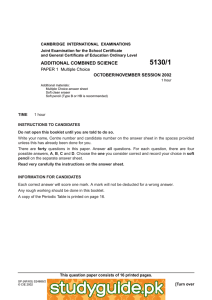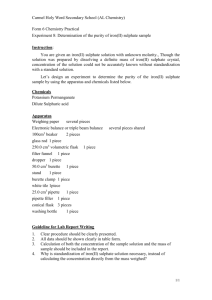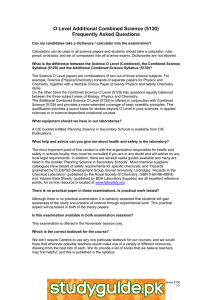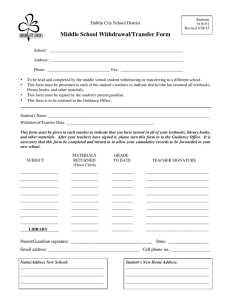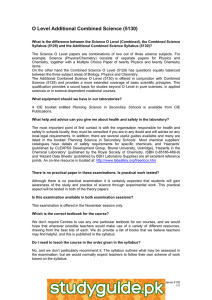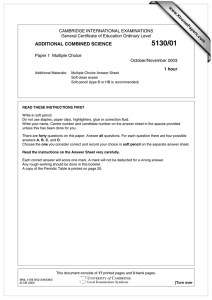www.XtremePapers.com
advertisement
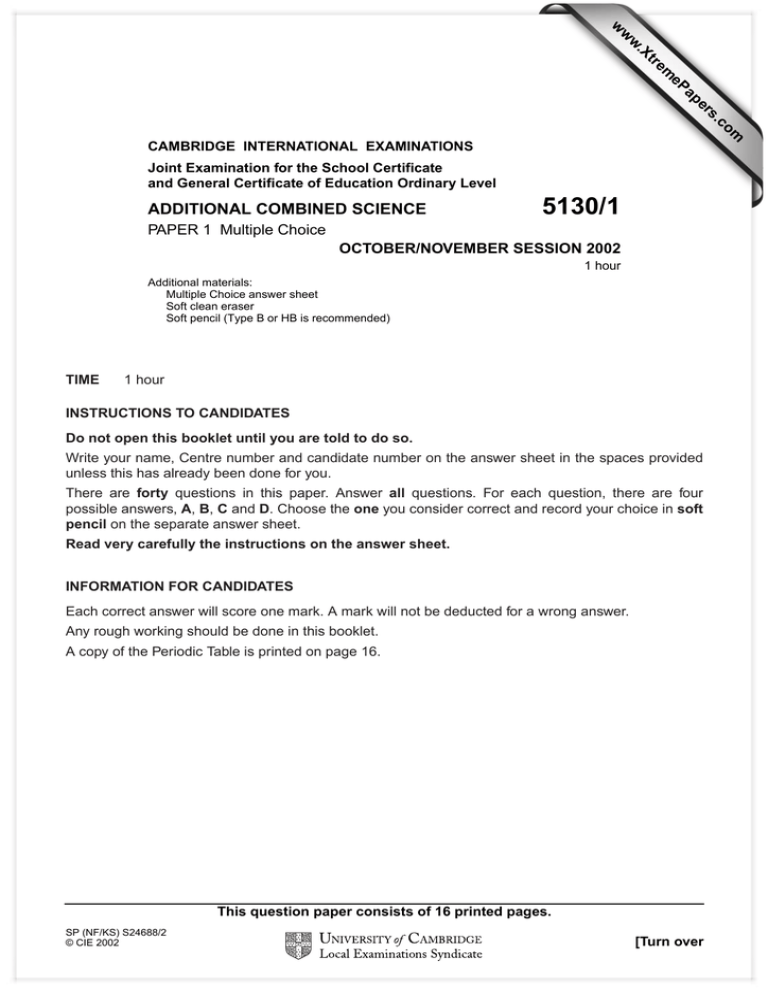
w w ap eP m e tr .X w om .c s er CAMBRIDGE INTERNATIONAL EXAMINATIONS Joint Examination for the School Certificate and General Certificate of Education Ordinary Level ADDITIONAL COMBINED SCIENCE 5130/1 PAPER 1 Multiple Choice OCTOBER/NOVEMBER SESSION 2002 1 hour Additional materials: Multiple Choice answer sheet Soft clean eraser Soft pencil (Type B or HB is recommended) TIME 1 hour INSTRUCTIONS TO CANDIDATES Do not open this booklet until you are told to do so. Write your name, Centre number and candidate number on the answer sheet in the spaces provided unless this has already been done for you. There are forty questions in this paper. Answer all questions. For each question, there are four possible answers, A, B, C and D. Choose the one you consider correct and record your choice in soft pencil on the separate answer sheet. Read very carefully the instructions on the answer sheet. INFORMATION FOR CANDIDATES Each correct answer will score one mark. A mark will not be deducted for a wrong answer. Any rough working should be done in this booklet. A copy of the Periodic Table is printed on page 16. This question paper consists of 16 printed pages. SP (NF/KS) S24688/2 © CIE 2002 [Turn over 2 1 The speed-time graph for a falling skydiver is shown below. The skydiver alters his fall by spreading his arms and legs and then by using a parachute. Which part of the graph shows the diver falling with terminal velocity? speed B C A D time 2 A coin is placed on top of a beaker, as shown. If the card is pulled away quickly, the coin does not move sideways but falls into the beaker. card beaker Which property of the coin makes this possible? A density B inertia C thickness D volume 5130/1/O/N/02 3 3 A body of mass 500 g was suspended in 100 cm3 of water by a piece of cotton as shown. cm3 200 150 100 50 What is the density of the body? A 4 0.38 g / cm3 B 2.63 g / cm3 C 5.00 g / cm3 D 5.56 g / cm3 A student adds different loads to the end of a spring. She finds the extension in each case and plots a graph of extension against load. Which is the correct graph? A extension B extension 0 0 0 0 load C extension load D extension 0 0 0 0 load 5130/1/O/N/02 load [Turn over 4 5 When a radioactive nucleus decays, a large amount of energy E is released. At the same time, a small amount of mass m is lost. Which of the following gives the amount of energy E ? (speed of light = c) A 6 mc2 B mc mc2 C D mc The diagram shows the melting points and boiling points of four substances. (∗ = melting point, • = boiling point.) Which substance is a gas at 150 °C and a solid at –50 °C? A 500 temperature / °C 400 300 200 100 0 -100 -200 -300 7 Which type of wave is longitudinal? A light wave B radio wave C sound wave D surface water wave 5130/1/O/N/02 B C D 5 8 The diagram shows a displacement / time curve produced by a sound wave of amplitude 2 units. +2 0 time 2 1 3 4 5 6 7 8 –2 Which diagram shows the same sound played more loudly? +2 +1 0 A –1 –2 time 1 2 3 4 5 6 7 8 1 2 3 4 5 6 7 8 +2 0 B time –1 +4 +2 0 C 1 2 3 4 5 6 7 8 time –2 –4 +4 +2 0 D time 1 2 3 4 5 6 7 8 –2 –4 9 A total current of 2 A flows between the terminals T1 and T2 in the circuit shown. 2Ω T1 2A T2 2Ω What is the potential difference between T1 and T2? A 0.5 V B 1V C 2V 5130/1/O/N/02 D 4V [Turn over 6 10 Which circuit is connected correctly to measure the current flowing through a fixed resistor and the potential difference across the ends of the same resistor? A B V V A A C D A V V A 11 The diagram shows some information printed on a light bulb. TTERBUY BE 60 W 240 V M ade in U K Which current is needed to light the bulb at normal brightness? A 0.25 A B 3.0 A C 4.0 A D 15 A 12 Why is a soft iron core placed inside the coil of an electric motor? A to decrease the electric current B to increase the electric current C to strengthen the magnetic field D to weaken the magnetic field 13 Carbon-14 is formed when neutrons from nuclei in the atmosphere bombard atmospheric nitrogen. 14N 7 + 10n → 146C + x What does x stand for? A 1H 1 B 4He 2 C 0 –1e 5130/1/O/N/02 D 1n 0 7 14 Which pair of nuclides are isotopes? A 12B 5 and 126C B 1H 1 C 12C 6 and 137N D 14C 6 and 147N and 21D 15 The diagrams represent the arrangement of particles in solids, liquids and gases. Which diagram represents a solution? A B C D 16 Which is the best piece of apparatus for transferring accurately 24.7 cm3 of a solution into a beaker? A burette B conical flask C measuring cylinder D pipette 37Cl. 17 An atom of chlorine is represented as 17 What is the total number of neutrons plus protons in the nucleus of this atom? A 17 B 20 C 37 D 54 18 Element Y has the electronic structure 2,8,2. Element Z has the electronic structure 2,8,6. The compound formed between Y and Z will probably A conduct electricity when molten. B have a low boiling point. C have a macromolecular structure. D not conduct electricity when dissolved in water. 5130/1/O/N/02 [Turn over 8 19 When 7 g of iron reacts with 4 g of sulphur, 11 g of iron(II) sulphide is produced. What will be produced if 7 g of iron is reacted with 7 g of sulphur? A 11 g of iron(II) sulphide and 3 g of unchanged iron B 11 g of iron(II) sulphide and 3 g of unchanged sulphur C 11 g of iron(II) sulphide only D 14 g of iron(II) sulphide only 20 The diagram shows the first step in the preparation of pure, dry crystals of zinc sulphate. hot dilute sulphuric acid Other steps are 1 2 3 unreacted zinc oxide powder evaporation filtration washing and drying In which order should these steps be carried out? A 1 2 3 B 1 3 2 C 2 1 3 D 2 3 1 21 How many electrons and protons are in an ion of an element in Group VI of the Periodic Table? number of electrons number of protons A 8 6 B 8 8 C 18 16 D 18 20 5130/1/O/N/02 9 22 Titrating dilute sulphuric acid against aqueous potassium carbonate can be used to prepare potassium sulphate. Which conclusion can be drawn from this information? A Potassium carbonate is insoluble in water. B Potassium carbonate neutralises sulphuric acid. C Potassium sulphate is a base. D Potassium sulphate is insoluble in water. 23 Which of the following oxides is most readily reduced to the metal by heating in a stream of hydrogen? A calcium oxide B copper(II) oxide C sodium oxide D zinc oxide 24 In a catalytic converter nitrogen oxides react with carbon monoxide. NOx + CO → X + Y What are X and Y? A carbon dioxide and nitrogen B carbon dioxide and water C oxygen and nitrogen D oxygen and water 25 Which electrolysis gives the products as shown in the table? electrolyte electrodes cathode (–ve) anode (+ve) A aqueous copper(II) sulphate copper Cu(s) Cu2+(aq) B aqueous copper(II) sulphate carbon O2(g) Cu2+(aq) C molten sodium chloride carbon H2(g) Cl 2(g) D dilute sulphuric acid platinum O2(g) H2(g) 5130/1/O/N/02 [Turn over 10 26 What is the general formula of an organic acid? A CnH2n+2 B CnH2n+1CO2H C CnH2nOn D CnH2n+1OH 27 Compound X undergoes an addition reaction with steam. What is X? A ethane B ethanol C ethene D methane 28 The table shows some characteristics of four types of cell. Which cell could be a root hair cell? nucleus chloroplast A B ✗ C ✗ D ✗ ✗ key = present ✗ = absent 5130/1/O/N/02 11 29 Germinating seeds were crushed with water and added to starch solution in tube X. Tube Y contained starch solution only. X Y starch solution plus crushed seeds starch solution only After 15 minutes, some liquid was removed from each tube and tested for starch. The table shows the results. tube X tube Y no starch starch present The remainder of each liquid was then tested for sugar. Which results were obtained? tube X tube Y A B ✗ C ✗ D ✗ ✗ key = sugar present ✗ = no sugar 5130/1/O/N/02 [Turn over 12 30 The diagram shows an experiment set up to investigate photosynthesis. bubbles of gas water water weed Which conditions will cause the plant to produce the most bubbles? dissolved carbon dioxide light A absent bright B absent dim C present bright D present dim 31 What is the function of the gall bladder? A absorption of fat B digestion of fat C production of bile D storage of bile 32 Which path does a molecule of carbon dioxide take as it leaves the body? A alveolus → bronchiole → bronchus B alveolus → bronchus C larynx D trachea → larynx → trachea → trachea → bronchiole → trachea → bronchus → bronchiole → bronchus → bronchiole 5130/1/O/N/02 13 33 The graph shows changes in a person’s body temperature plotted against time. 39 period 1 period 2 38 body temperature / °C 37 36 0 20 40 60 80 100 time / min What could cause the changes in body temperature in periods 1 and 2? period 1 period 2 A reduced air temperature increased air temperature B reduced air temperature shivering C vigorous exercise increased sweating D vigorous exercise shivering 34 The chart shows the risk of heart disease developing in men who smoke cigarettes. 1200 1000 number of men 800 dying from heart disease per 100 000 600 age under 45 age 45 age 55-64 400 200 0 5 10 15 20 number of cigarettes smoked per day Which group of men is most at risk? A men aged under 45 who smoke 5 cigarettes per day B men aged under 45 who smoke 20 cigarettes per day C men aged 55-64 who smoke 5 cigarettes per day D men aged 55-64 who smoke 20 cigarettes per day 5130/1/O/N/02 [Turn over 14 35 What is the main source of energy for green plants? A carbon dioxide B chlorophyll C heat D light 36 The diagram shows part of the water cycle. W Y X What are processes W, X and Y? W X Y A evaporation drainage transpiration B evaporation transpiration rainfall C transpiration drainage rainfall D transpiration rainfall drainage 5130/1/O/N/02 15 37 The diagram shows a food chain found in a freshwater lake that is polluted by insecticides. Which organisms in the food chain will accumulate the highest concentration of insecticide in their body tissues? A B C single cell organisms insect larvae fish D birds 38 Sexual reproduction is a process in which A all types of organism reproduce. B many cells of one type fuse with a single cell of another type. C nuclei of two specialised cells fuse together. D parents produce genetically identical offspring. 39 Which of the following can cross the placenta? fatty acids urea red blood cells A ✗ B ✗ ✗ C ✗ D ✗ ✗ key = can cross the placenta ✗ = cannot cross the placenta 40 A person with Down’s syndrome is born with 47 chromosomes in each of their cells, instead of 46. What could cause this? A A mutation occurred during the production of the egg cell. B More than one sperm fused with the egg at fertilisation. C Radiation caused a change in structure of a gene in the father’s sperm. D The mother was exposed to harmful chemicals while she was pregnant. 5130/1/O/N/02 Magnesium Sodium 5130/1/O/N/02 Strontium 89 Key b X a † 72 b = proton (atomic) number X = atomic symbol a = relative atomic mass *58-71 Lanthanoid series †90-103 Actinoid series 88 Ac Actinium Ra Radium Fr Francium 87 * Hafnium Lanthanum 57 178 Hf 40 Zirconium Zr 91 Titanium 139 Yttrium 22 48 Ti La 39 Y 89 Scandium 21 227 56 Barium Caesium 45 Sc 226 55 137 Ba 133 Cs 38 Rubidium 37 88 Sr 85 Calcium Rb 19 20 40 Ca 39 K 12 24 Mg 23 Na Beryllium 4 Lithium Potassium 11 3 9 Be 7 II Li I 51 93 Ta 181 Niobium Nb 90 58 73 52 96 Mo W 184 Protactinium Thorium 55 Tc 186 Re 144 Nd 92 60 Uranium U 238 Neodymium 75 Rhenium 43 Technetium 25 Manganese Mn 27 59 28 59 29 64 30 65 5 Ru 101 Iron 190 Pm Osmium Os Np 93 Neptunium 61 Promethium 76 44 Ruthenium 26 56 Fe 150 Sm Pu 94 Plutonium 62 152 Eu Am 95 Americium 63 Europium 78 Platinum Pt Iridium 195 Ir 46 Palladium Pd 106 Nickel Ni 192 Samarium 77 45 Rhodium Rh 103 Cobalt Co Gd 157 Gold Au 197 Silver 96 64 Curium Cm Gadolinium 79 47 Ag 108 Copper Cu 201 Bk Terbium Tb 159 Mercury Hg 97 Berkelium 65 80 48 Cadmium Cd 112 Zinc Zn 11 6 Dy 162 Thallium Tl 204 Indium Cf 98 Californium 66 Es Holmium Ho 165 Lead Pb 207 Tin 99 Einsteinium 67 82 50 119 Sn 115 32 Germanium Ge 73 Silicon In Gallium Dysprosium 81 49 31 70 Ga 14 28 Si Carbon 27 Aluminium 13 12 C Al Boron B 7 14 75 Sb 122 Arsenic As Bi 209 Fermium Fm Erbium Er 167 Bismuth 100 68 83 51 Antimony 33 15 Phosphorus P 31 Nitrogen N 8 Se 79 Sulphur S 32 Oxygen Po 169 Md Thulium Tm 101 Mendelevium 69 84 Polonium 52 Tellurium Te 128 Selenium 34 16 16 O 9 Yb 173 Astatine At Iodine I 127 Bromine Br 80 Chlorine No 102 Nobelium 70 Ytterbium 85 53 35 17 Cl 35.5 Fluorine F 19 Lr Lutetium Lu 175 Radon Rn Xenon Xe 131 Krypton Kr 84 Argon Ar 40 Neon 103 Lawrencium 71 86 54 36 18 10 Ne 20 Helium 2 0 Hydrogen VII 4 VI He V 1 IV H III The volume of one mole of any gas is 24 dm3 at room temperature and pressure (r.t.p.). 91 Pa Th 232 Praseodymium Cerium 59 141 Pr 140 74 Tungsten 42 Molybdenum 24 Chromium Cr Ce Tantalum 41 23 Vanadium V 1 Group DATA SHEET The Periodic Table of the Elements 16
